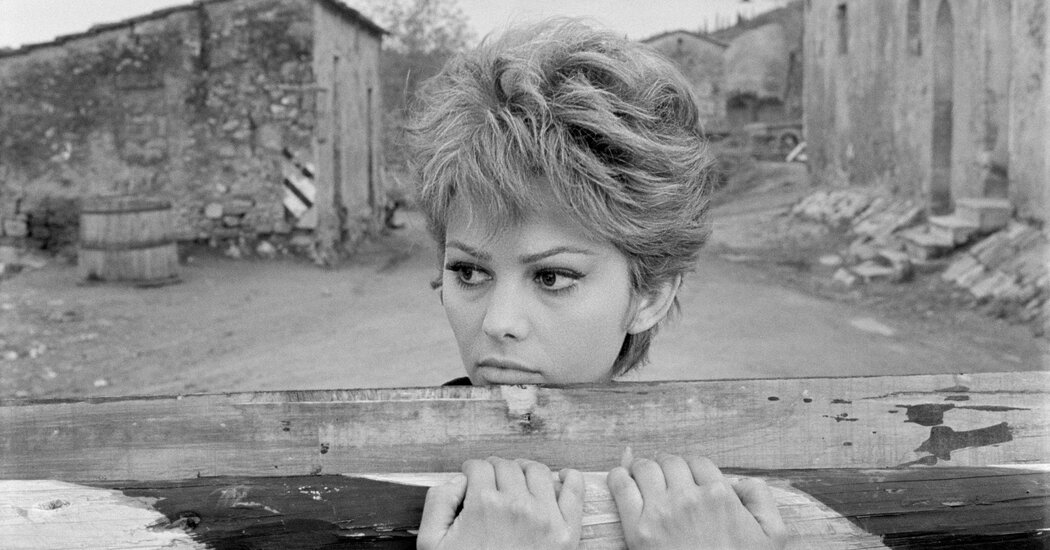
Claudia Cardinale: 6 Decades in the Movies
On a recent afternoon in Rome, Claudia Cardinale recalled the many heartthrobs she worked with during her more than six-decade movie career, and let out a full-throated laugh.
“And they also wanted to make love with me,” she said, “but I always refused.”
Over the years, the fresh-faced beauty — who David Niven, her co-star in an early “Pink Panther” movie, once described as Italy’s best invention besides spaghetti — had given the cold shoulder to more than one famous screen Casanova, Cardinale said in an interview. “They tried,” she added. “I turned down seducers.”
Then she laughed her mischievous laugh again.
Cardinale, 84, was in Rome last month for the Italian presentation of a newly restored version of Luigi Comencini’s 1963 film “La ragazza di Bube” (“Bebo’s Girl”), about a small-town girl who stands by her man, even after he is convicted of a crime and goes to jail.
“Bebo’s Girl,” which earned Cardinale her first prestigious acting award, Italy’s Nastro d’Argento for best actress, will be shown on Friday at the Museum of Modern Art in New York, the first in a 23-film retrospective honoring the Tunisian-born Italian actress that runs through Feb. 21. It is one of a handful of times that the museum has presented a tribute to a living actor in its more than 90-year history.
“Beautiful actresses come and go,” Joshua Siegel, a MoMA curator, said in video message shown at the Rome screening. “But they usually don’t endure over a period of some 60, 65 years.”
Cardinale said she would not be in New York for the retrospective; she no longer travels like she used to. It tires her — she now uses a cane to get around — and she prefers to stay out of the limelight.
Cardinale was in the public eye long enough, starring in more than 100 films since 1956. For many film buffs, she is best remembered for her roles in Italian cinema classics: as the young wife Ginetta in Luchino Visconti’s “Rocco and His Brothers”; as Angelica, a commoner whose vitality and beauty seduces Sicilian aristocracy in Visconti’s “The Leopard”; as the enigmatic Claudia in Federico Fellini’s “8 ½,”; or as the feisty Jill, the widow with a ranch to protect in Sergio Leone’s “Once Upon a Time in the West.”
She also has boasting rights from her star turn in Werner Herzog’s “Fitzcarraldo,” a legendarily difficult movie that was shot in the Peruvian jungle and described in The New York Times as a favorite of “connoisseurs of production disasters,” and the movie and its making as “fables of daft aspiration.”
Cardinale has said that “Fitzcarraldo” was the adventure of her life, but during an interview last month, she said she had no particular favorites. “My God, I’ve done some many, I don’t know which one I prefer,” she said, and laughed again. “Maybe ‘Once Upon a Time in the West,’” she said, “and then so many others.”
The MoMA tribute, organized with Cinecittà, Italy’s national film company, includes some of Cardinale’s better known performances. But for the occasion, Cinecittà also restored three works less likely to be known to American audiences: “Bebo’s Girl,” but also Marco Ferreri’s 1972 “The Audience,” about a man’s obsession with meeting with the pope, and Pasquale Squitieri’s 1990 “Atto di Dolore,” about a widow whose son is a drug addict.
Though Cardinale’s name will forever be associated with classics of Italian cinema, she spoke little Italian when she first set foot there in 1957.
Cardinale was born in Tunisia in 1938, into a family of Sicilian immigrants that had settled there decades before. “I still feel a little bit Tunisian,” Cardinale told the news agency ANSA in May at a ceremony to name a street in her honor in the port town La Goulette, near Tunis.
In 1957, she won the Most Beautiful Italian in Tunisia contest, which came with what turned out to be her ticket to stardom: a trip to the Venice Film Festival.
In “Claudia Cardinale: The Indomitable,” a book published by Cinecittà and Electa to coincide with the MoMA tribute, the author and critic Masolino D’Amico recalls being at that festival and seeing Cardinale for the first time, “splendid in all her youthfulness,” wearing an emerald green bikini and posing for the paparazzi.
“She seemed to think that small shower of camera clicks was like a game,” Masolino writes. “She was not — I understand this clearly now — trying to be sexy, and maybe not even attractive. She was simply happy to be there.”
In Venice, she caught the eye of Franco Cristaldi, at the time one of Italy’s most important producers, who, in Pygmalion fashion, transformed the young ingénue into an in-demand movie star. He also became her life partner, adopting her son, Patrick Cristaldi. Now 64, he was initially passed off as her brother so as not to crack her “virginal feel and glow,” or to scandalize society, Cardinale’s daughter, Claudia Squitieri said.
Stardom had a price. Cristaldi demanded hard work and discipline, and in 1962 drafted a contract that oversaw every aspect of the actress’s life, professional and private. She accepted, if reluctantly: Her family depended on her, and she had a child to raise.
That life ended when she met the director Pasquale Squitieri in 1973 on the set of “I guappi,” (“Blood Brothers”) and the two fell madly in love. Their careers took a hit: Cristaldi was a powerful producer in Italy whom industry people feared crossing.
Cardinale would make nine films with Squitieri, even after she moved to Paris and he remained in Rome. Never married, they eventually split, but remained close.
Claudia Squitieri and Patrick Cristaldi now live with their mother in a house near Fontainebleau, France, where Cardinale has created a foundation to support two causes close to her heart: women’s rights and the environment. Cardinale has been a UNESCO good will ambassador since 2000, for campaigning work to improve the status of women and girls, and she is the honorary president of Green Cross Italy, an environment advocacy group that sponsors an award for sustainable films at the Venice Film Festival. The foundation is “something to continue her shine,” said Squitieri, who runs the organization for her mother.
Cardinale said she was very close to Squitieri. “I am lucky to have this daughter, who I adore,” she said. “She looks after me; she looks after everything.”
Because Cardinale won’t be in New York this week, Squitieri will do the honors. On Friday, the “Bebo’s Girl” screening will be followed by “Un Cardinale donna” (“A Woman Cardinal”), a whimsical short featuring the actress, produced for the retrospective by Manuel Maria Perrone.
Speaking at the film’s Rome premiere, Perrone said that “dealing with an idol, with such a strong icon, is something extremely difficult, even fragile.”
“She’s been doing this her whole life,” he said. “Being an icon is her job.”
Claudia Cardinale
Feb. 3 through Feb. 21, at the Museum of Modern Art; moma.org.




